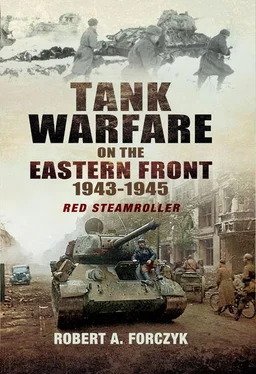The 12.Panzer-Division conducted the rearguard mission in Orel, delaying the Soviet entry into the city and ensuring that all bridges over the Oka River were destroyed. On the night of 4 August, 12.Panzer-Division evacuated the city and the Soviet 63rd Army marched in the next morning. Badanov’s 4 GTA and Rodin’s 2 TA mounted a pursuit against Model’s forces as they withdrew to the Hagen Stellung, but Model used his Panzer-Divisionen as mobile rearguards, successfully fending off Soviet probing attacks. During these missions, German tank platoons were deployed in defilade positions with their main guns over the rear deck; when the lead Soviet tanks appeared they would be knocked out and the German tanks would fall back to the next position to repeat again. These delay tactics were costly for the Soviets and induced caution in the advance tank brigades. By 18 August, Model’s AOK 9 and the remnants of PzAOK 2 were entrenched in the Hagen Stellung and the Stavka declared Operation Kutusov to be completed with the liquidation of the Orel Salient. The 38-day Operation Kutusov inflicted four times as many casualties upon Model’s forces as Operation Zitadelle had, a total of 88,000, including 27,000 dead or missing. All eight Panzer-Divisionen under Model’s command had suffered considerable losses, including 229 tanks and tank destroyers. Between Zitadelle and Kutusov , Heeresgruppe Mitte had lost one-third of its armour.
While Kutusov was an operational triumph for the Red Army, at the tactical level it was a frustrating and costly effort. The three Soviet fronts had suffered a total of 429,890 casualties during the operation and lost 2,586 tanks – enormous losses even by Red Army standards. Furthermore, the performance of all three Soviet tank armies was sub-par since they were used to fighting positional rather than manoeuvre battles. Instead of penetrating and encircling German units, Soviet armour pushed German units back to their next delay position. Although hard-pressed, the German tankers had great sport ambushing the Soviet vanguard battalions then falling back to the next position. The Soviets triumphed in Kutusov primarily because of their artillery and air support, plus plentiful infantry, not because of their tankers. Thus one of the lessons for the Red Army about Kutusov was that it needed to employ its tank armies more efficiently to achieve decisive, rather than local, results. Numbers had not won the battle for the Soviets, dogged persistence had. For the Germans, Kutusov was an ominous preview of coming attractions.
The Mius River Battles, 17 July–2 August 1943
Von Manstein had only been able to assemble a large enough force to conduct Zitadelle by prioritizing reinforcements and replacements to Hoth and Kempf, at the expense of his other two armies – Generaloberst Eberhard von Mackensen’s 1.Panzerarmee (PzAOK 1) and General der Infanterie Karl Adolf Hollidt’s 6.Armee (AOK 6). Although von Manstein fully expected that the Soviet Southwest and Southern Fronts could mount a major assault across either the Donets or the Mius rivers at any time, he took a calculated risk that PzAOK 1 and AOK 6 could fend off these attacks while he used his main armoured forces to crush the Voronezh Front. For their part, the Stavka directed these two fronts to build up their forces and wait for the right moment. Unlike the resource-starved Wehrmacht, the Red Army was able to deploy three mechanized corps, one tank corps and 20 other tank units with a total of about 1,300 tanks to support these two secondary fronts.
Hollidt’s AOK 6 was holding an extended front along the Mius River with nine infantry divisions in three corps. Although the rebuilt AOK 6 had not been seriously attacked along the Mius since early March, Soviet artillery had still managed to inflict 1,000–2,000 casualties per month during the lull, so Hollidt’s infantry units were well below authorized strength. Furthermore, the Mius was only a minor obstacle, averaging about 50 metres in width and not very deep; AOK 6 was dug in on the western side, behind mines and barbed wire obstacles. The German HKL (main line of resistance) was based upon company and battalion-size Stützpunkte . For anti-armour support, Hollidt had Sturmgeschütz-Abteilungen 209 and 243 with about 40–50 StuG-IIIs. German defensive doctrine at this point was based upon a well-defended HKL to slow the enemy advance and rapid counter-attacks to smash any breakthroughs. However, Hollidt’s only mobile reserve was Generalleutnant Gerhard Graf von Schwerin’s 16.Panzergrenadier-Division, equipped with 58 tanks (incl. 37 Pz III and 11 Pz IV).
General-polkovnik Fyodor I. Tolbukhin’s Southern Front intended to cross the Mius River between Dmytrivka and Kuybyshevo and smash through the centre of Hollidt’s line, held by the XVII Armeekorps. Tolbukhin massed the 2nd Guards Army and the 5th Shock Army in this sector with General-leytenant Karp V. Sviridov’s 2nd Guards Mechanized Corps (2 GMC) and General-major Trofim I. Tanaschishin’s 4th Guards Mechanized Corps (4 GMC) ready to exploit the expected breakthrough. In order to deceive von Manstein, Malinovsky’s Southwest Front would make diversionary attacks against Hollidt’s left flank along the Donets with 1st and 3rd Guards Armies. On the morning of 17 July, Tolbukhin attacked after a short, sharp artillery preparation. The 44th Army made a supporting attack against the XXIX Armeekorps to the south, but the main effort committed seven rifle divisions against the boundary of the 294. and 306.Infanterie-Divisionen of the XVII Armeekorps. The Soviet 8th Air Army had complete air superiority over this sector, providing effective close air support as Soviet infantry poured across the river. Both German divisions were hard hit by the Soviet artillery, suffering 2,100 casualties on the first day, and the Soviet rifle divisions quickly managed to seize a 4km-deep bridgehead across the Mius before local German counter-attacks began to slow the advance. The 44th Army’s supporting attack managed to gain a small bridgehead as well.
Hollidt realized that he needed to counter-attack immediately, before Tolbukhin got his mechanized corps across the Mius and before the XVII Armeekorps was overwhelmed. He appealed to von Manstein and the OKH for assistance, but decided to commit von Schwerin’s 16.Panzergrenadier-Division as soon as possible. Von Manstein had already committed part of Nehring’s XXIV Panzerkorps to deal with Malinovsky’s diversionary attacks around Izyum, but sent the 23.Panzer-Division on its way to Hollidt. Hitler ordered von Manstein to transfer two divisions from the II.SS-Panzerkorps and the 3.Panzer-Division to eliminate the Soviet bridgehead across the Mius front, but they would take time to disengage from the Belgorod sector.
On the morning of 18 July, von Schwerin’s division attempted to attack the left side of the Soviet bridgehead, but soon ran straight into Sviridov’s 2 GMC, which had crossed the Mius. Intense Soviet anti-tank and artillery fire broke up the German attack and von Schwerin retreated after losing 20 tanks. Once the German counter-attack had been repulsed, the 5th Shock Army continued to advance and captured the towns of Stepanovka and Marinovka. By the end of the second day, Tolbukhin’s bridgehead across Mius had been enlarged to 30km deep and 45km wide. Upon learning of von Schwerin’s defeat, Hollidt requested that Generalleutnant Nikolaus von Vormann’s 23.Panzer-Division move up quickly and launch another counter-attack against the bridgehead on 19 July. Kampfgruppe Sander, which included I./Pz.Rgt.201, a company of Marder tank destroyers and a reconnaissance company, moved out on the evening of 18–19 July and conducted a 170km night road march, with the rest of the division following. Amazingly, von Vormann’s division was able to begin an attack toward Stepanovka at 0700 hours on 19 July, but quickly ran into strong anti-tank defences, supported by tanks from 2 GMC and 4 GMC. The 16.Panzergrenadier-Division conducted a supporting attack with its 20 operational tanks. Despite some Stuka sorties and an artillery preparation, two attacks on Stepanovka were repulsed. The I./Pz.Rgt.201 lost 11 tanks destroyed and all four company commanders were killed or wounded. Altogether, 23.Panzer-Division suffered 369 casualties, including 112 dead or missing. Von Vorman claimed that his division had knocked out 14 enemy tanks and 20 anti-tank guns, but the Soviet line was barely dented. {140} Following this failed attack, both the 16.Panzergrenadier-Division and the 23.Panzer-Division shifted to the defence from 20–29 July, assisting the XVII Armeekorps’ defence. Although Tolbukhin’s infantry and armour pounded on the thin German line around the bridgehead on 20–21 July and even gained a little more ground, they could not break out. On the afternoon of 22 July, Tolbukhin committed Tanaschishin’s 4 GMC against the 16.Panzergrenadier-Division sector southwest of Stepanovka. Tanaschishin advanced with more than 140 tanks in a large formation, while von Schwerin only had a few tanks left and the assault guns of Sturmgeschütz-Abteilung 236. Once again, it was Luftwaffe batteries of 8.8cm flak guns that saved the day, destroying much of Tanaschishin’s armour before it could overrun von Schwerin’s frontline positions – the 4 GMC attack collapsed. {141}
Читать дальше








![John Stieber - Against the Odds - Survival on the Russian Front 1944-1945 [2nd Edition]](/books/405234/john-stieber-against-the-odds-survival-on-the-russian-front-1944-1945-2nd-edition-thumb.webp)



